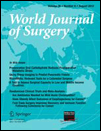The Role of Simple Renal Cysts, Abdominal Wall Hernia, and Chronic Obstructive Pulmonary Disease as Predictive Factors for Aortoiliac Aneurysmatic Disease
Abstract
Background
This study was designed to investigate the possible predictive value of simple renal cysts (SRCs), abdominal wall hernia (AWH), and chronic obstructive pulmonary disease (COPD) for the presence of abdominal aortoiliac aneurysms (AAA).
Methods
Between January 2006 and January 2011, we treated 170 consecutive patients with aortoiliac pathology. Patients’ data were prospectively collected and were retrospectively analyzed. Of these patients, 110 (study group) had AAA (group 1) and 60 (control group) had aortoiliac occlusive disease (AOD; group 2). Moreover, patients of group 1 were subdivided, according to aneurysm’s diameter to subgroup 1A (aortic aneurysm diameter >55 mm and/or common iliac diameter >22 mm; n = 62) and subgroup 1B (aortic aneurysm diameter ≤55 mm and/or common iliac diameter ≤22 mm; n = 48). All patients underwent a computed tomographic angiography, and datasets were analyzed for aortoiliac and SRCs’ anatomical data. Additionally collected data were atherosclerotic risk factors, history of previous or current AWH, and COPD.
Results
The two groups as well as the two AAA subgroups were homogenous regarding demographics and atherosclerotic risk factors. Univariate analysis showed that incidence of SRCs, AWH, and COPD were significant predictive factors for presence of AAA. Multivariate analysis identified SRCs and AWH as independent predictive factors for the presence of AAA. In association with the aneurysm’s size, multivariate analysis failed to show any predictive value of SRCs, AWH, or COPD.
Conclusions
Results of our study showed a positive predictive value of SRCs and AWH for presence of AAA and a strong relationship but not with predictive value between COPD and AAA. These data might be helpful for the early recognition of patients at risk for an aortoiliac aneurysm formation and for establishment of AAAs population-based screening. Further research of pathophysiological commonalities between the four studied entities may be extremely helpful for designing future preventive and treatment strategy of AAAs.
Conflict of interest
None.




